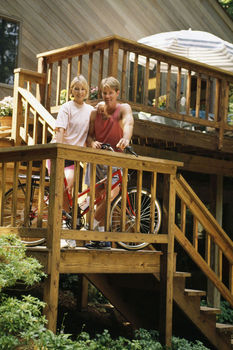How to Build Stairs for a Deck
Building stairs for a deck is a pretty simple procedure, once you’ve built a deck or patio. So far, we’ve covered “How to Build a Deck” and “How to Build a Patio”, but we’ve only brushed over the building of stairs. So to complete our series, here’s “How to Build Stairs for a Deck“.
This is going to be simple, in comparison to the rest of the project. Most of the time, you stairs are only going to require a few steps spaced out evenly, and are hardly the equivalent of building a staircase inside the home. Getting the incline right can be tricky, but in the case of a few steps, a few trial and error calculations should suffice. Learn what the “rise to run ratio” is, then build stairs according to an acceptable ratio.
What Is Rise to Run Ratio?
- Rise – The height between two steps on a staircase.
- Run – The depth of the step on a staircase. Also called the “tread”. Indicates how much room your foot has to step on.
The conventional approach is to make the run and the rise x2 (twice the rise) should equal between 24″ and 26″. So if the rise is 8 inches (x2 = 16), then the run should be 8-10 inches. If the rise is 10 inches (x2 = 20), then the run should be 4-6 inches (clearly unacceptable). You’ll quickly see the outer limits to what the rise should be, keeping in mind that the ideal tread path should be about ten to twelve inches.
Measure the Vertical Distance

How to Build Stairs for a Deck
When preparing to build your staircase, first measure the vertical distance the stairs need to climb. A rough riser height is 7, so divide your vertical distance by 7, to give you the number of stairs you need. This is a rough number, since your rise isn’t likely to divide perfectly into 7.
Calculate the total run of the stairs by multiplying your tread depth by the number of stairs you have, minus one. The -1 is figured in, because the final step is your deck floor. When you get this calculation, you know how far out from the patio your staircase should start.
Measure the Stringers
The “stringers” are the up and down boards that support your treads, which rise and are nailed to your stairs. Imagine walking up the stairs and stubbing your toe as you do so – the stringer is what you would stub your toe again. Usually, a stringer is a piece of 2×12 lumber.
The stringer is important in measuring your overall rise from the ground to the deck. Using rise and run calculations, make your measurements and mark them along the stringer.
Cut Stringers – Set Stringers into Place
Next, using a hand saw or circular saw, cut the stringers out. Set these boards into place on your deck. Cut them to shape with a hand saw, adding a stringer every 16″ along the width of the stairway.
The bottom of the stringers should rest on a cement footing. This footing can be either a prefab cement slab or a poured cement base.
Install the Treads
Once you have the stringers on your stairs, add the treads to your staircase. The treads are the actual steps. The width of the steps should be easy to figure, since the stringers are already in place.
Screw the treads to the stringers by using galvanized decking screws, using 2×6 boards cut to the proper length.
Building Stairs for a Deck
Mastering how to build stairs for a deck has one or two tricky aspects, but after building a full deck or patio, this should be a pretty simple process in comparison. Be careful to calculate rise and run correctly, because you want to build steady and secure stairs, so people from 3 years to 83 years old can make it up the stairs.
